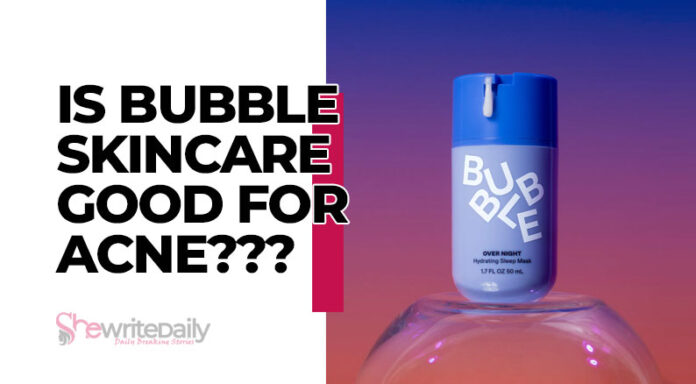Acne is a common skin condition that affects millions of people worldwide, causing physical and psychological distress. In the search for effective acne treatments, bubble skincare has emerged as a popular option.
This article aims to objectively assess whether bubble skincare is beneficial for acne-prone skin. To provide a comprehensive analysis, the article will begin by exploring the nature of acne and its underlying causes. It will then delve into the potential benefits of bubble skincare, examining the scientific evidence behind its effectiveness. Additionally, practical tips for incorporating bubble skincare into an acne routine will be discussed.
However, it is important to consider potential drawbacks and limitations of bubble skincare for acne treatment. By adopting an academic and impartial approach, this article will provide readers with a well-rounded understanding of the topic, allowing them to make informed decisions about their skincare regimen.
Understanding Acne and its Causes
Acne is a complex dermatological condition characterized by the formation of comedones, papules, pustules, and nodules. These arise due to an interplay of factors such as excessive sebum production, follicular hyperkeratinization, bacterial colonization, and inflammation. It is a common concern among individuals, especially during adolescence.
Understanding the causes of acne is crucial in developing effective treatment strategies and skincare routines that cater to the specific needs of acne-prone individuals.
Exploring the Benefits of Bubble Skincare
One compelling aspect to consider when examining the advantages of bubble skincare is its potential to address skin concerns and improve overall complexion.
The effervescent nature of bubble skincare products allows for deep cleansing and exfoliation, which can help to unclog pores and remove impurities.
Additionally, the foaming action can promote better absorption of active ingredients, leading to enhanced efficacy in treating acne and promoting healthier skin.
The Science Behind Bubble Skincare Products
The scientific principles that underlie the efficacy of bubble skincare products are rooted in the unique properties of their effervescent formulations, which contribute to their deep cleansing and exfoliating capabilities.
These properties include:
- Increased oxygenation: Bubble skincare products release oxygen bubbles upon contact with the skin, promoting better blood circulation and oxygenation of the skin cells.
- Gentle exfoliation: The foaming action of the bubbles helps to remove dead skin cells and unclog pores without causing irritation or damage to the skin.
- Enhanced absorption: The micro-bubbles in these products can penetrate deep into the skin, allowing for better absorption of active ingredients.
- pH balancing: Many bubble skincare products are formulated with ingredients that help to balance the skin’s pH level, promoting a healthier skin barrier.
Tips for Incorporating Bubble Skincare into Your Acne Routine
To effectively integrate bubble skincare products into a routine targeting skin imperfections, individuals can adopt certain strategies that optimize the benefits of these effervescent formulations.
Firstly, it is important to cleanse the skin thoroughly before using bubble skincare products to ensure maximum absorption.
Secondly, individuals should consider incorporating bubble skincare into their routine at least once or twice a week to avoid overexfoliation.
Finally, it is essential to follow up with a moisturizer to maintain the skin’s hydration and prevent dryness.
Considerations and Potential Drawbacks of Bubble Skincare for Acne
Considerations and potential drawbacks arise when incorporating effervescent formulations into an acne routine, necessitating a careful evaluation of their impact on skin health and overall efficacy. While bubble skincare products may be appealing due to their fun and unique textures, they may not be suitable for all individuals with acne-prone skin. Some potential drawbacks include the presence of potentially irritating ingredients, such as fragrances or essential oils, and the risk of over-exfoliation. It is important to consider these factors before incorporating bubble skincare into an acne routine.
| Potential Drawbacks | Impact on Skin Health |
|---|---|
| Presence of potentially irritating ingredients | May cause skin irritation or inflammation |
| Risk of over-exfoliation | Can lead to dryness, redness, and increased sensitivity |
| Ineffectiveness for deep pore cleansing | May not effectively remove impurities and excess sebum from the pores |
By carefully considering these potential drawbacks and evaluating the specific needs of their skin, individuals can make informed decisions about whether bubble skincare is suitable for their acne routine. Consulting with a dermatologist or skincare professional can also provide valuable guidance and ensure the best possible outcomes for acne-prone skin.
Conclusion
Bubble skincare products have gained popularity in recent years for their unique and fun nature. While they may provide some benefits for acne-prone skin, it’s important to consider their potential drawbacks as well. Understanding the science behind bubble skincare and incorporating it into your acne routine can be helpful, but it shouldn’t replace proven acne treatments.
It’s always best to consult with a dermatologist for personalized advice and to ensure the most effective approach to managing acne.


